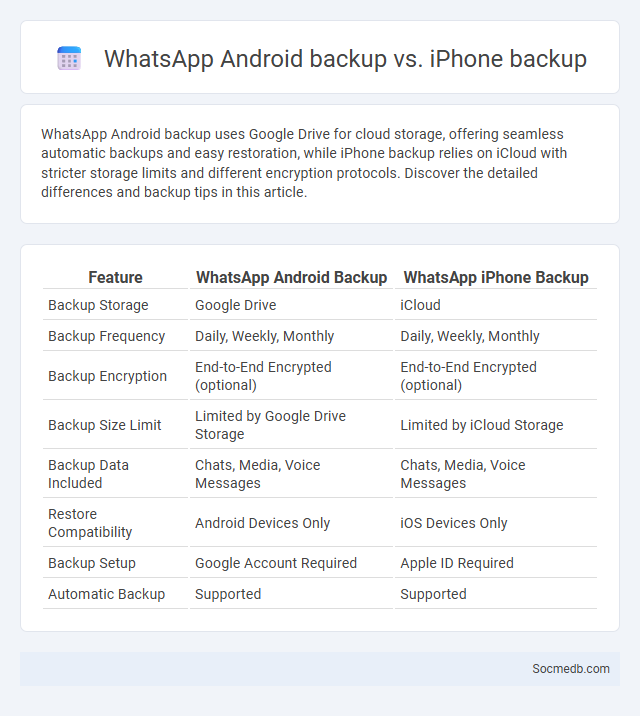
Photo illustration: WhatsApp Android backup vs iPhone backup
WhatsApp Android backup uses Google Drive for cloud storage, offering seamless automatic backups and easy restoration, while iPhone backup relies on iCloud with stricter storage limits and different encryption protocols. Discover the detailed differences and backup tips in this article.
Table of Comparison
| Feature | WhatsApp Android Backup | WhatsApp iPhone Backup |
|---|---|---|
| Backup Storage | Google Drive | iCloud |
| Backup Frequency | Daily, Weekly, Monthly | Daily, Weekly, Monthly |
| Backup Encryption | End-to-End Encrypted (optional) | End-to-End Encrypted (optional) |
| Backup Size Limit | Limited by Google Drive Storage | Limited by iCloud Storage |
| Backup Data Included | Chats, Media, Voice Messages | Chats, Media, Voice Messages |
| Restore Compatibility | Android Devices Only | iOS Devices Only |
| Backup Setup | Google Account Required | Apple ID Required |
| Automatic Backup | Supported | Supported |
Introduction to WhatsApp Backup Options
WhatsApp offers several backup options to secure chat history and media files, including local device storage and cloud services like Google Drive for Android and iCloud for iOS. Users can enable automatic backups daily, weekly, or monthly to ensure data preservation without manual intervention. This functionality is essential for restoring conversations when switching devices or recovering from accidental data loss.
Overview: Android vs. iPhone vs. Chat Backup
Social media data management varies significantly across Android, iPhone, and chat backup platforms, with Android offering flexible, third-party app support while iPhone emphasizes secure, integrated iCloud backups for messages and media. Chat backup solutions like WhatsApp provide cross-platform cloud storage using Google Drive for Android and iCloud for iPhone, ensuring seamless data restoration and continuity. Understanding these ecosystems helps optimize social media data preservation, enhancing user experience and security.
Backup Storage Locations and Encryption
Social media platforms store vast amounts of user data across multiple backup storage locations, including cloud servers and geographically distributed data centers, to ensure redundancy and rapid recovery in case of data loss. Encryption techniques such as AES-256 and TLS are employed to protect this sensitive data both at rest and in transit, minimizing the risk of unauthorized access and data breaches. Robust encryption combined with secure backup storage locations is critical for maintaining user privacy and data integrity in social media ecosystems.
Backup Frequency and Automation Settings
Regular backup frequency ensures that social media content, user data, and engagement metrics are consistently preserved, minimizing risks of data loss from hacks or platform changes. Automation settings streamline the backup process, scheduling regular data exports and synchronization without manual intervention, which enhances efficiency and reduces human error. Utilizing cloud-based backup solutions with customizable automation options provides scalable security for social media accounts across multiple platforms.
File Types and Data Included in Backups
Social media backup files commonly include media formats such as JPEG, PNG, MP4, and GIF to preserve photos, videos, and animations shared across platforms. These backups incorporate text data like posts, comments, messages, and metadata including timestamps, user IDs, and geolocation tags to maintain context and authenticity. Comprehensive social media backups ensure preservation of multimedia content alongside interaction history for effective data recovery and compliance.
Restoring Chats: Cross-Platform Challenges
Restoring chats across social media platforms faces significant technical challenges due to varied data encryption methods and proprietary storage formats. Users often encounter data loss when switching devices or platforms because interoperability protocols remain limited and inconsistent. Efforts to standardize chat backup processes aim to improve seamless restoration, but cross-platform synchronization still requires advanced solutions to ensure data integrity and privacy.
Cloud Service Integration: Google Drive vs. iCloud
Cloud service integration significantly enhances your social media experience by streamlining content storage and sharing. Google Drive offers extensive collaboration tools, seamless integration with Google Workspace, and 15 GB of free storage, making it ideal for managing large media files across platforms. In contrast, iCloud provides optimized syncing within Apple's ecosystem, with 5 GB of free storage and robust privacy features, ensuring smooth access to social media content on iOS and macOS devices.
Privacy and Security Considerations
Protect your personal information on social media by regularly updating privacy settings and limiting the audience for your posts to trusted connections. Use strong, unique passwords and enable two-factor authentication to safeguard your accounts from unauthorized access. Be cautious about the data you share and review app permissions to minimize risks of data breaches and identity theft.
Troubleshooting Common Backup Issues
Social media users frequently encounter backup issues such as incomplete data export, corrupted files, or synchronization errors with cloud storage services. To troubleshoot these problems, ensure stable internet connectivity, verify app permissions for storage access, and update the platform to the latest version to patch known bugs. Regularly clearing cache and using official backup tools like Facebook's Download Your Information or Instagram's Data Download feature can prevent data loss and optimize backup reliability.
Best Practices for Reliable WhatsApp Backups
Ensuring the reliability of your WhatsApp backups involves regularly updating the app to benefit from the latest security features and bug fixes. You should enable automatic backups to cloud services like Google Drive or iCloud, which securely store your chat history and media files. Verifying sufficient storage space and stable internet connectivity plays a crucial role in preventing backup failures and data loss.
 socmedb.com
socmedb.com